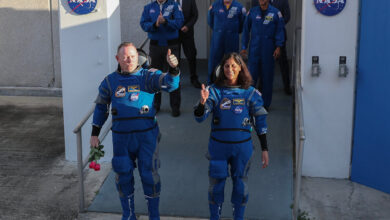McDonald’s Is Bigger Than Ever: How ‘Super Size Me’ Lost the Culture War

The camera zooms in on a large woman, sitting on a cooler at the beach. It cuts to a shirtless man, also quite large, his face blurred out. The next shot shows another overweight man, sitting on a beach towel with plastic grocery bags arrayed in front of him.
“America has now become the fattest nation in the world. Congratulations,” a voice narrates. “Nearly 100 million Americans are today either overweight or obese.” At the end of this soliloquy, the opening credits roll — accompanied by Queen’s “Fat Bottomed Girls.”
So begins “Super Size Me,” which was released 20 years ago this month.
Directed by and starring Morgan Spurlock, the bootstrapped, lo-fi documentary was a smash hit, grossing more than $22 million on a $65,000 budget. Following Mr. Spurlock as he ate nothing but McDonald’s for 30 days — and the ill effects that diet had on his health — the film became the high-water mark in a tide of sentiment against fast food. McDonald’s, specifically, became a symbol for the glossy hegemony of American capitalism both at home and abroad.
“McJobs” became a term for low-paying, dead-end positions, “McMansions” for garish, oversize houses. In 1992, the political theorist Benjamin Barber used the term “McWorld” as shorthand for emergent neoliberal dominance; seven years later, protesters against the World Trade Organization seemed to agree, launching a newspaper box through a McDonald’s window during the “Battle of Seattle” marches.
Two years after that, Eric Schlosser’s “Fast Food Nation” was published. A broad indictment of the entire fast-food industry, the best seller accused the industry of being bad for the environment, rife with labor issues, culturally flattening and culinarily fattening.
That last point was the primary focus for Mr. Spurlock’s stunt. Awareness was raised, alarms were sounded and nightly news segments ensued. Six weeks after the film’s release, McDonald’s discontinued its Super Size menu, though a company spokesman said at the time that the film had “nothing to do with that whatsoever.”
It would have been easy to call the cultural moment a brand crisis for fast food.
But two decades later, not only is McDonald’s bigger than ever, with nearly 42,000 global locations, but fast food in general has boomed. There are now some 40 chains with more than 500 locations in the United States. Fast food is the second-largest private employment sector in the country, after hospitals, and 36 percent of Americans — about 84 million people — eat fast food on any given day. The three major appeals of fast food remain intact: It’s cheap, it’s convenient and people like the way it tastes.
“I used to own shares of McDonald’s,” said Jay Zagorsky, a professor at Boston University’s Questrom School of Business who has studied fast food in America. “Around the time of ‘Super Size Me,’ I sold off the shares, and now I’m saying to myself why? That was one of the greatest stocks.”
He’s right. The stock price of McDonald’s hit an all-time high in January, and has gone up nearly 1,000 percent since “Super Size Me” came out — nearly twice the return of the S&P 500.
While the sector’s financial performance was largely unaffected, there was a very real image problem, to the point that fast-food companies were compared to Big Tobacco. A big part of that problem had to do with children, who were seen not as informed consumers but rather as victims of their parents’ choices, the industry’s predatory advertising, or both. In fact, the inspiration for “Super Size Me” was a lawsuit filed by two New York City parents against McDonald’s, claiming that the company’s food had made their children severely obese.
In the end, the chains handled the brand crisis with the very tool — their most powerful — that had caused the problem in the first place: marketing.
‘Stop Listening to the Haters’
Historically, fast-food companies have been very astute about marketing to children, realizing decades ago that creating customers early means creating customers for life. At the peak of his fame in the 1980s, Ronald McDonald was in some countries more recognizable to children than Mickey Mouse. In 2000, 90 percent of children ages 6 to 9 visited a McDonald’s in a given month.
But as Frances Fleming-Milici, the director of marketing initiatives at the UConn Rudd Center for Food Policy and Health, put it, “If it’s marketed to children, it’s probably bad for you.”
That became increasingly clear in the mid-2000s. Childhood obesity rates had nearly tripled in 25 years, and the public outcry was growing more urgent. A consortium of large food brands, including McDonald’s, Burger King, PepsiCo and Coca-Cola, tried to get out in front of the problem. They formed the Children’s Food and Beverage Advertising Initiative, and the participating corporations self-imposed limits on advertising to children under 13 (later 12).
In place of that marketing to children, though, the big fast-food chains have found something arguably more potent, with McDonald’s, as ever, leading the way.
“They’re hyperfocusing on what they call fan-favorite moments, trying to essentially identify how we emotionally connect to McDonald’s,” said Kaitlin Ceckowski, who researches fast-food marketing strategies at Mintel, a market research agency. “What ‘human truths’ exist around their brand?”
That “human truths” idea — essentially, the genuine emotional resonance of eating McDonald’s — originated in part from Wieden+Kennedy and the Narrative Group, the two creative agencies that the chain hired in 2019 and 2020.
As W+K New York’s co-chief creative officer, Brandon Henderson, explained to AdAge in March, “When we first started with McDonald’s, they were hesitant to be themselves and had been listening to the haters since the ‘Super Size Me’ documentary. I think the big shift we gave them was to stop listening to the haters and listen to the fans.”
For the agencies, the lodestar of that strategy was the idea that “No matter who you are, everyone has a McDonald’s order.”
A Universal Experience
It turns out that years of saturating American childhood with fast food has paid real dividends. The 6-to-9-year-olds in that 2000 statistic are now younger millennials, among the group with the highest rate of fast-food consumption today. They have a lifetime of memories that connect them to fast-food brands, and to McDonald’s in particular.
All that needed to be done was to connect the power of that comfort and nostalgia to the power of celebrity. Fast food isn’t just cheap, accessible calories; it’s a universal experience. You’re eating the same fries as your idols.
That idea animated a 2020 Super Bowl ad that showed the McDonald’s orders of famous people both real (Kim Kardashian) and not (Dracula). That spot led, in turn, to a phenomenally successful campaign designed around the preferred orders of celebrities. The first of these, the Travis Scott menu, featured the go-to meal of the Houston rapper and doubled sales of Quarter Pounders in the first week. As a result, the market capitalization of McDonald’s went up by $10 billion.
Other chains have followed suit, with partnerships between Megan Thee Stallion and Popeyes, Ice Spice and Dunkin’, Justin Bieber and Tim Hortons, and Lil Nas X and Taco Bell, which named the pop star its “chief impact officer.”
“It’s not directly targeting children, but let’s be clear: The celebrity meals are for BTS, Travis Scott, Cardi B and J Balvin,” said Ms. Ceckowski. “These are people who resonate with younger audiences.”
They are also celebrities who resonate in particular with younger audiences of color, who tend to have higher rates of fast-food consumption than white consumers.
So while the vast majority of fast-food marketing is no longer aimed at children, per se — the ad budget expressly for kids’ meals and healthy menu items represents just 2 percent of the total spending — that only means that children are now going after the menu items they are seeing advertised. According to a Rudd Center study, this means they are simply ordering from the adult menu at a younger age.
In that same study, 20 percent of parents reported buying additional items for their children, which at Wendy’s could mean an order of fries to round out a meal that comes with apple slices, or at McDonald’s a soda to accompany a Happy Meal that now features only milk.
“If you look at where they put their ad dollars, it’s really just the highest-calorie items,” Ms. Fleming-Milici said. “These healthier menu items appear to be a bit of a public relations effort.”
In the age of social media, brands don’t even have to advertise expressly to children anyway, in the way they might have in the past, by buying a slot during Saturday-morning cartoons or on Nickelodeon. On TikTok and Instagram, kids of all ages see the same content we all do.
Younger people are also making content of their own, getting in on the marketing campaigns with thousands of videos of themselves ordering, unwrapping, eating — a sort of advertising Amway.
‘A Form of Civic Participation’
We may be living in a new era of social-media-driven viral marketing in the palms of millennial hands, but what hasn’t really changed is the food.
The Wendy’s Baconator, for instance, was introduced in 2007, three years after “Super Size Me” came out, and it remains one of the chain’s most popular items. A protein conglomeration of a half-pound of beef, six pieces of bacon and two slices of cheese, each burger delivers 1,010 calories and 67 grams of fat.
Burger King offers a triple Whopper, which carries similar nutritional values, even without the optional bacon and cheese. And at Chipotle, a brand often held up as evidence of healthier fast-food tastes, a standard chicken burrito can easily contain 1,100 calories. The classic Big Mac remains basically intact, at a relatively tame 590 calories.
There are still efforts to steer Americans, particularly American children, away from these options. In April, Senators Bernie Sanders, Cory Booker and Peter Welch introduced the Childhood Diabetes Reduction Act, which would ban advertising junk food to children and require stronger health and nutrition warning labels. The law “would take on the greed of the food and beverage industry and address the growing diabetes and obesity epidemics negatively impacting millions of American children and families across the country,” according to a news release from Mr. Sanders.
Fast food may be a tough habit to legislate away, though. In 2016, 91 percent of parents reported buying lunch or dinner for their child in the past week from one of the four biggest chains — a significant increase compared with the 79 percent who did in 2010 and the 83 percent in 2013.
The problem may be that while we are often scolded for eating at these restaurants, we are more often encouraged. There is a vast network of enticement — from huge marketing budgets, to family traditions, to just the tastiness of the meals — that pushes diners toward the drive-through.
In its harsh depiction of American obesity, “Super Size Me” seemed to judge individuals for their failure to resist that machine. But according to Virgie Tovar, who has written books about weight discrimination, that’s an unfair indictment — especially when applied to consumers for whom a trip to McDonald’s might well offer the most accessible version of the American dream.
“People in my generation, and certainly Gen Z, probably aren’t going to be homeowners,” Ms. Tovar said. “Job insecurity is really high. All these markers of what it means to be a successful American are increasingly inaccessible to these younger generations. And I think about the things that are: They’re these cheaper consumer goods, and some of them are food.”
Eating McDonald’s, she said, should be seen as “a form of civic participation — whether we want to admit it or not.”



